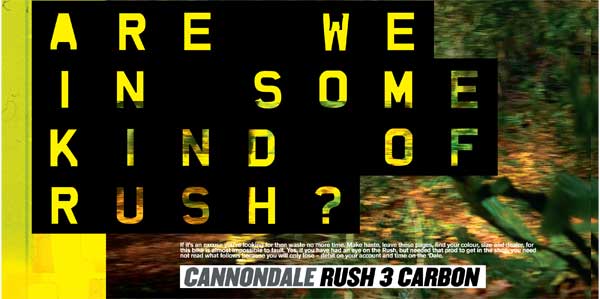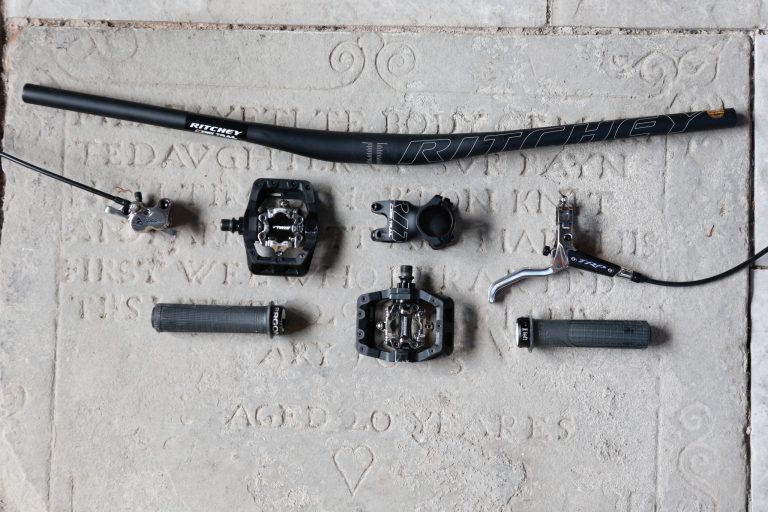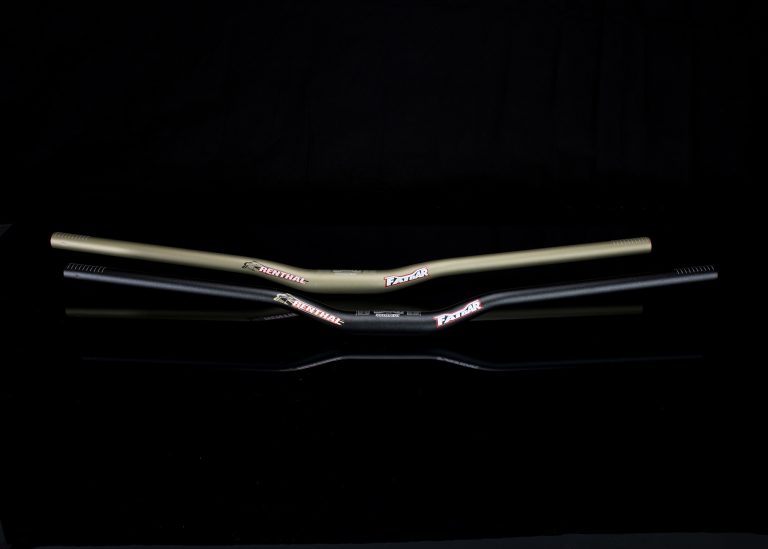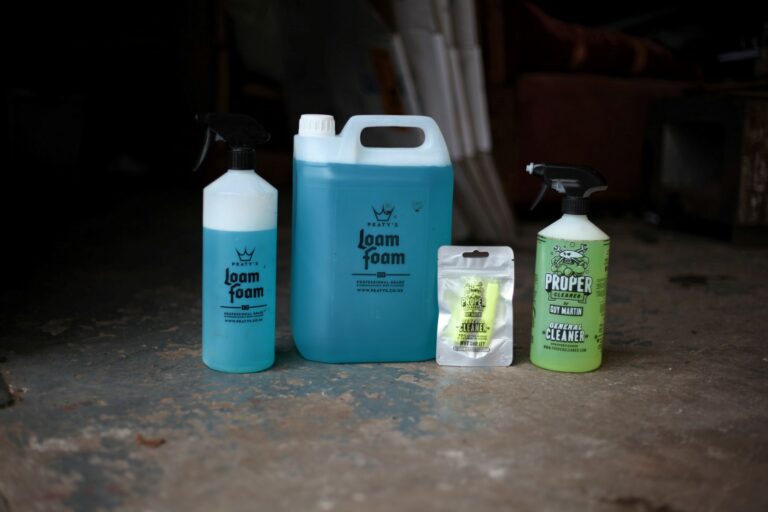
Bike Test: The Cannondale Rush
It is possibly by mistake that a bike of such badness has emerged out of the “marathon bike” category stamped on it so definitively by Cannondale, Tinker and the boys. Yes it’s all the things the American company say it is, and yes its carbon front triangle, light (ish) weight, made of light (ish) components, allows no end of miles to be spun into those cranks.
If you want to run the hideous stem as supplied, or have no intention of ripping the living daylights out of the hideously thin tyres within seconds of hitting the green light, then all I can say is you are missing out. Big style. Evaluating and exploring the Rush more fully draws the rider up front. This the Rush 3 Carbon, is the only one in the range fitted with a ‘standard’ Fox fork and not Cannondale’s own Lefty. The longer, stiffer Fox 32, with 120mm travel, has played a huge part in allowing the name ‘hooligan’ to be etched deeply into the soul of this bike.
The forks make the Rush slacker, improved tyres give the bike traction and a short stem gives this bike a licence to play holy hell with anything in front of it, a slight touch of WRC mindset in a Millennium Nova shell possibly, but fun definitely. With the Fox, 60mm stem and Torro tyres allowing the metamorphosis from…well lets not even go there aye…we unleashed the beast onto some of the UK’s finest trail centres. One lap, flat out. With a touch of TLC the Rush will hit the mid–twenty mark weight wise. With a dose more fitness (lets not forget the engine room here) it’ll get to that first summit pretty sharpish. After all that’s what’s it’s made for. Yet it’s from this point on that is the make or break point for this bike. It depends on componentry. Remember this is a carbon fibre marathon bike closer to four than five (inches that is). Take into account that many forest centres have become eroded, washed out and tough. Maybe the long stem was a good idea after all, because as soon as you tip the nose of
this bike even mildly downslope it revs up.
On a well surfaced day, give it all its got in these places, on other more stormy days away from the tourist lines, well this is where the Rush needs that subtle touch, pick up and avoid the bigger collisions, seek the smooth.

This all sounds like the Rush needs a soft touch, a bit of lovin’ on the hills. Not in the slightest. What the Rush needs is to attack everything in its sight. It’s hard to think if there is another bike just over a hundred mil travel that even gets close to this bike on descents. ‘Hardtail Billy’ in the office once questioned the very idea of having such a bike like this in the magazine. “Should we be putting bikes not made to leave the ground in the magazine?” To quell these thoughts I booked an uplift, six riders of varying abilities, and roughly seven easy to medium difficulty downhill tracks to session.
The talk on the way to our office day out was mostly spent exploring various psychosis, Billy’s addiction to hardtails being one of them. Quickly identifying the fact that he is a) contrary and b) averse to the idea of expensive toys, our man of the web came around to the idea that indeed he did need softening up and to get away from the self harm he was inflicting on himself by year on year hardtail addiction. By dinnertime the Rush was all his. Selfishly diving into the front seat of the van enabling him to get first dibs on the bikes at the top of every run he was soon talking the talk, “It handles so well”… the Rush is inspirational.
So what makes this bike so good? Very simply it’s because it feels like it has more travel than it’s got. There’s obviously two ways to look at that. Firstly the mountainbike industry is awash with the incorrect assumption that (any) six inch bike will be better downhill and on rough ground than a four inch bike. Many people obviously need immunisation from this travel disease because this broad generalisation is simply not the case. Bikes that are fast at descending and fun get the fundamentals right. Key word in there being ‘fast’. Three key areas are geometry, suspension and design. But you cannot have one without the other to achieve a thoroughbred. For example there are many great 140mm travel bikes out there that have exceptional suspension, grip and design but are not fast bikes. On a more basic level there are bikes with great geometry and rubbish suspension and there are bikes with marvellous designs but pathetic angles.
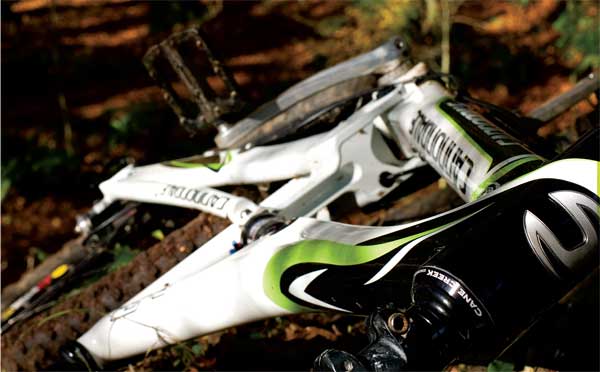
Now if this is what 108mm of travel feels like then other companies have got it staggeringly wrong. To analyse why this might be the case and find out why the Rush is just so good is pretty much way out of the timescale lent to bike testing in this magazine. Single pivot with a firm compression tuned Fox, an aluminium swingarm paired with a carbon front end, that gives it ‘feel’, is a combination of other little things too. Flex could be one of them. But don’t be scared. Cannondale have got it right and that’s all that matters. Whilst the ‘Dale is great even with fast rolling Maxxis Crossmark tyres for example, Dirt’s Ed Haythornthwaite, long time Cannondale fanatic, pulled a masterstroke in fitting the large volume Bontrager Big Earl. This gave the bike an even better feel, more cushioning and an altogether ‘bigger’ feel to it.
CONCLUSION
Rip the bar and stem off, take them down the recycling centre. Lever the rubber off the rims and flush it down the toilet. Get a roll of Velcro and line the seat and chain stays to protect your ears from noise pollution, add quality tyres, and an attacking stem. Head for the nearest slopes, aim and fire. One of the best handling mountainbikes ever made. Great wheelbase, head angle…stop it! Are we in some kind of rush? Definitely.
More from Cannondale in the links below:
CANNONDALE JEKYLL 2015 WITH JEROME CLEMENTZ

